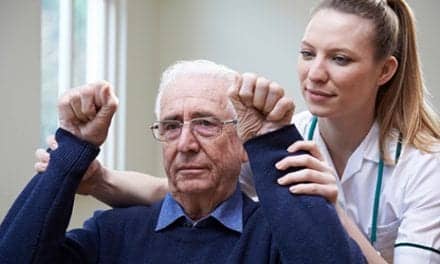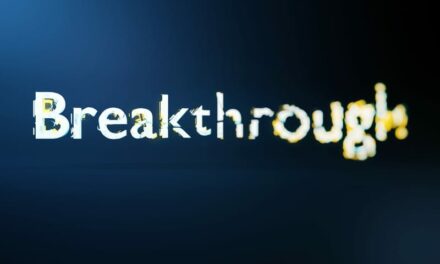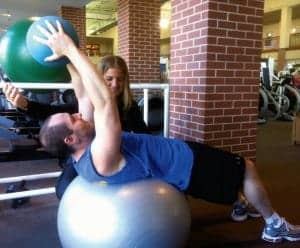
Rebecca King, a lead health and fitness instructor at the East Jefferson General Hospital Wellness Center, incorporates the use of therapy balls with athletes to assist in addressing weak lumbar muscles and enhancing core stability.
Springtime always brings excitement and anticipation to the masses of athletes who are ready to kick into high gear. They have waited all winter to shed the layers of workout gear and reinvigorate their programs to train for the athletic competitions they favor. Compared to winter activities, spring sports draw a drastic increase in participation. This increase is most commonly seen in running, swimming, baseball, golf, and tennis. The athletes who participate in these activities will range from the elite professionals to the weekend warriors or the exercise-obsessed Baby Boomers. Elite pro athletes, however, enjoy several advantages that the other groups do not, including a team of professionals making sure they train properly to avoid injury as well as heal their injuries or help them eat right, and proper equipment to perform the sport. Everyone else is left to train themselves and hopefully do everything right so they may achieve their goals and not become injured.
Whether the weekend warriors are young or in the Baby Boomer generation, they are usually reluctant to slow down as they age. However, their bodies may have a different idea. People with sports injuries, led by the Boomers, are now the No. 2 group of patients who seek treatment from a physician, behind those complaining of a cold.1 This trend will only continue to increase as more of the Boomers and the younger generation feel an obligation to stay healthy and exercise or push themselves to achieve that bucket list goal, such as qualifying for and running the Boston Marathon.
TRAIN TO WIN
In any sport, the key to success is the actual training that goes into it. With sports such as running, golf, and baseball, the specific aspects of training can be drastically different. Proper training does need to occur for the athletes to achieve continued success and remain injury free. The weekend athlete has several options in regard to how they approach training. The ideal situation would be to have the training performed by a coach or professional, who would meet with the athlete. They map out a program, monitor performance, and set goals related to what the athlete wants to achieve. However, this scenario does require a financial outlay for the athlete, which some may not be able to afford.
Another training solution, though less than ideal, is for recreational athletes to build a program themselves. Many ideas about training, programs, and general knowledge can be obtained from reliable sources ranging from online research to recommendations from athletic colleagues. The disadvantage of this approach is that most people have very limited knowledge of how to train properly. They are limited not only in medical knowledge, but also in knowledge about what equipment to purchase as well as how to set goals. As a result of this approach, failure in their programs becomes a high probability and the risk of injury rises. Therefore, it is best to advise the weekend athletes to enlist the advice of a professional.
Professional training for weekend athletes can take many forms. For example, the athlete can hire a trainer who practices independently, or if the athlete belongs to a health club, training services at the club may be enlisted. East Jefferson General Hospital (EJGH), a community-owned hospital located in southeastern Louisiana, is an example of a facility able to offer residents of the community a full continuum to address specific training needs. This includes a Wellness Center and Outpatient Rehab Clinic that offers professional training and rehabilitation necessary to guide athletes on their journeys.
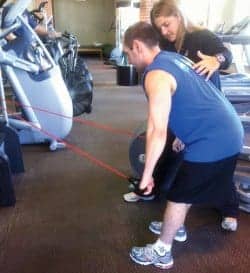
Rebecca King assists a patient in therapy band exercises. The bands serve as a tool for warmups and stretching, and mimic the range of motion in most sports.
The Wellness Center is a 38,000-square-foot, state-of-the-art medical fitness facility, offering a variety of cardiovascular and weight training equipment, an aquatics area with two pools, a whirlpool, a multipurpose activity room for classes, and a raised walking track. The center retains a staff that includes health and fitness instructors, certified and degreed personal trainers, licensed massage therapists, clinical exercise physiologists, administrative staff, member service representatives, and dedicated volunteers. The staff can provide expert training for any sport to the weekend athlete. This can range from helping an athlete improve performance on the golf course, to helping complete an Ironman Triathlon.
Even though the center has an extensive amount of equipment available for training purposes, many times the trainers and instructors will utilize different types of resistance training tools.With a focus on function and targeted training, the instructors will use tools such as therapy balls and therapy bands for strengthening as well as foam rollers for stretching routines.
Rebecca King, one of the lead health and fitness instructors at the center, has a clientele that includes weekend athletes in sports such as swimming, track, cycling, and running. King incorporates all aspects of equipment offered at the center, including the machines, aquatic therapy pools, and fitness track. However, it is difficult for patients to have this type of specialized equipment set up at home. Therefore, bringing in the bands, balls, and other basic types of equipment is ideal for the athlete to obtain carryover from the program she develops. One way King obtains carryover is by utilizing the therapy bands both on land and in the aquatic pools. It is a great tool for warm-ups, as well as stretching and range of motion exercises for all types of sports. The therapy bands are very versatile in that they mimic almost any sport motion and provide a functional training exercise in the process. One particular example of utilizing the therapy bands in the pool is with athletic swimmers. “The bands present a great exercise tool to work on follow-through exercises with swimmers. This helps to facilitate the explosive speed needed during the overhead stroke to effectively push through the water,” King explains. The versatility of therapy bands helps to grade the exercise easily and also instruct the clients about how to perform independently.
Another area of training gaining more attention is abdominal core training. It is an area that is often overlooked by all athletes, but plays a key role in injury prevention as well as success in a particular sport. Depending on the sport, King will utilize Pilates techniques to further address certain abdominal core areas. Many of the Pilates techniques actually mimic sport exercises so they are very functional and sport specific. This would include sports like swimming and tennis. Medicine and therapy balls also can be easily incorporated into any fitness program, to assist in core stabilization exercises. King usually incorporates the use of therapy balls with any athlete to help address weak lumbar muscles as well as underutilized abdominal musculature for all sports.
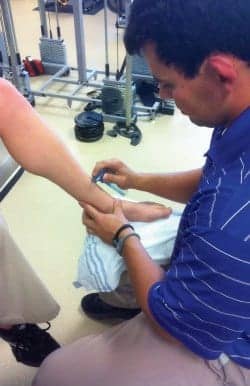
Dennis Romig, PT, treats a patient using an instrument-assisted soft tissue mobilization technique, which allows the weekend warrior to continue normal activities during treatment.
REHAB THE INJURIES
The weekend athlete works hard to consistently maintain a training program and participate in the desired sports. These days, more of the athletes are vigilant about performing at their best, with the hopes of achieving success from an aging body. The overwhelming majority of recreational athletes will be fortunate not to have to deal with significant injuries such as fractures, head injuries, or other devastating situations that might end the career of a professional athlete. Typically, as the recreational athlete ages, the susceptibility to sports injuries will rise.2 Generally, the injuries that are seen in these cases are soft tissue in nature or have a pain management component. These will include tendinitis, joint pain, muscle strains, and sprains to the shoulder, elbow, knee, or any other area of the body.
Strong-minded weekend warriors will attempt to treat their own injuries in many cases. However, this is an area for which the expert training and advice of qualified professionals is needed so that further injury is not facilitated. Amelia Embley, supervisor of the EJGH Outpatient Rehab clinic, leads a team of therapists that is more advanced than any other practice in the area. The therapists have obtained certifications in all areas of physical therapy practice and utilize the latest techniques in the services provided. One of the main specialty areas of the clinic is treating soft tissue injuries. The goal of all these techniques is to provide patient-focused outcomes in the most time-efficient manner.
The choice of which treatment program to use is very specific to the type of injury the weekend athlete might exhibit. In almost all cases, the use of cryotherapy or moist heat will play a role in the pre- or post-treatment session. Also, evaluating the training program will help the therapist decide whether the athlete is performing the activities of training correctly or whether the program should be modified. However, when it comes down to actual treatment, the expertise of the therapist comes into play. Dennis Romig is a physical therapist at the EJGH Outpatient Rehab clinic who specializes in utilizing instrument-assisted soft tissue mobilization techniques to address the injuries seen. Providing the most effective treatment in the shortest amount of time is the ideal situation that the weekend athlete is looking for. The techniques that Romig uses accomplish this goal. These treatments provide a rehabilitation program that stimulates the regenerative healing process of the body. This approach is a noninvasive therapy that works fast and consistently. It rejuvenates the muscles, tendons, and ligaments and does not just treat the symptoms or hide a problem with a temporary solution. Instead, these techniques stimulate the body to heal properly and completely. Best of all for the weekend athlete, they can usually stay active and continue their normal activities while in treatment. Romig has used these treatment methods to treat professional athletes as well as the weekend warriors. He has addressed patellar tendinitis, chronic ankle pain, and many other soft tissue issues in his patients. The athletes are pleased with the fact that they can see immediate results, remain active in their program, and not have to invest months of treatment to fix the problem. Along with the specialized treatment, Romig also will incorporate the use of the therabands and other basic equipment to strengthen and ensure compliance with the patients’ home program.
BACK ON THE FIELD
The Baby Boomers and weekend warriors will continue to push the envelope of aging and remain as active as possible. Whether they are just getting started or continuing an established program, remaining sedentary is not an option. Recreational athletes need the tools to perform at their best and maintain this performance over time with the hope of not getting injured. As part of a sports-focused continuum, the athlete has the confidence they will be trained well. If injury does present itself, knowing that they can get back to a training routine as quickly as possible restores their confidence. The professionals at EJGH work hard to train the athlete, rehab the athlete, and take pride in watching them achieve their goals in life.
Todd S. Danos, MBA, LOTR, is director of Therapy Services, East Jefferson General Hospital, Metairie, La. For more information, contact .
REFERENCES
- Hobson K. The Weekend Warrior’s Guide to Eight Common Injuries. U.S. News & World Report. 2007. Available at: www.health.usnews.com/usnews/health/070608/8injuries.sportsmed_print.htm. Accessed October 25, 2011.
- Chew C. Baby Boomers Sports and Gym Injury Risks. Available at: www.healthguidance.org. Accessed October 31, 2011.


